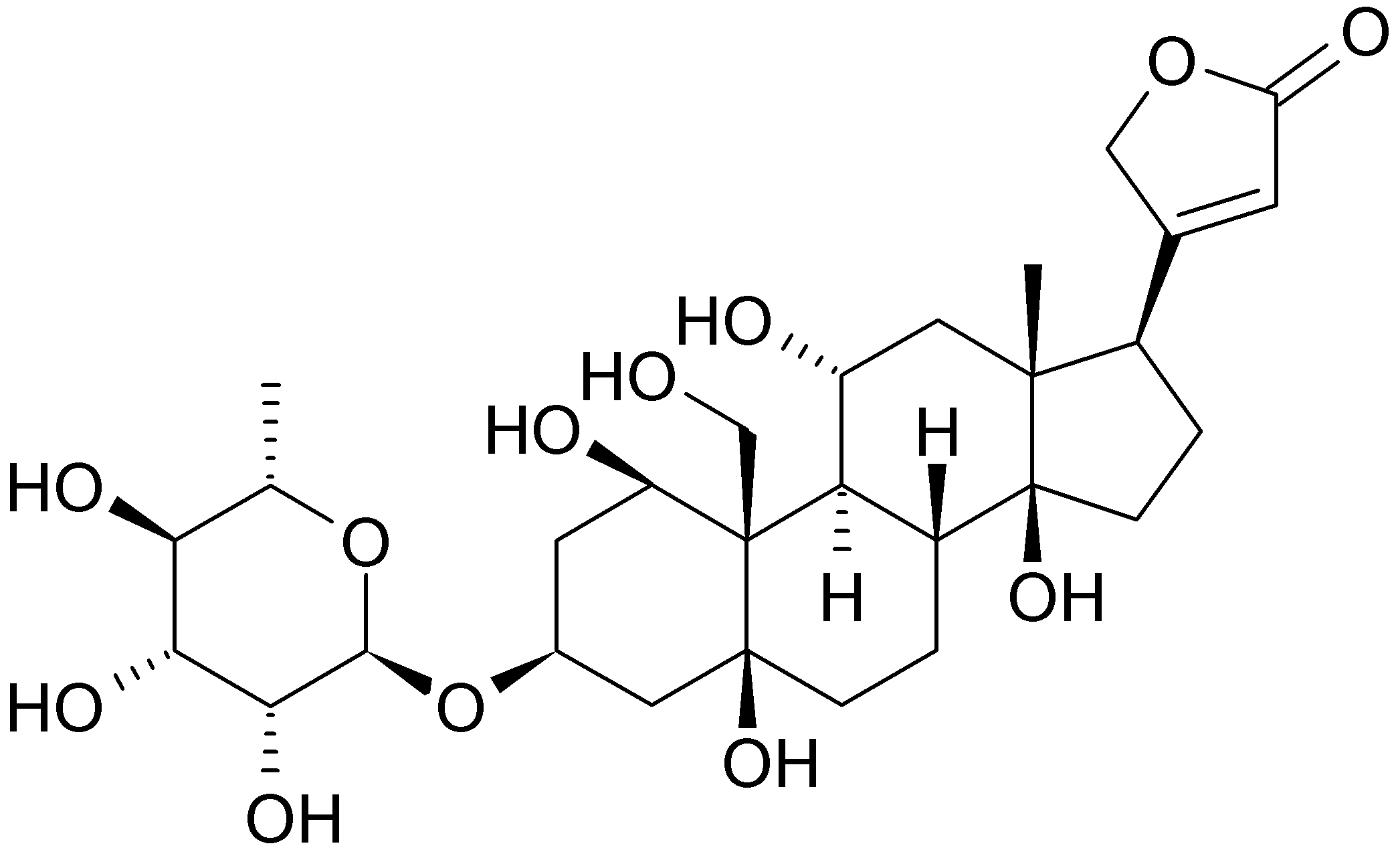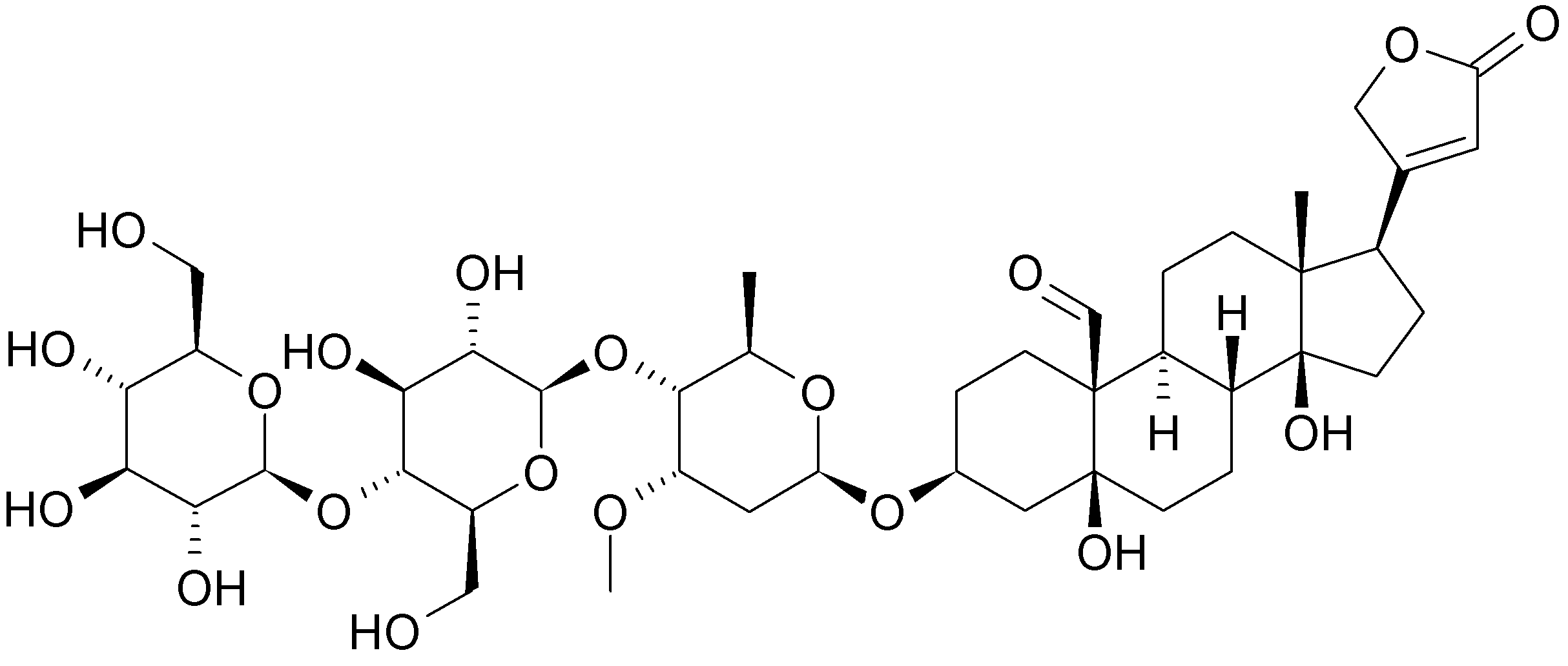Ouabain
 | |
| Clinical data | |
|---|---|
| ATC code | |
| Identifiers | |
| CAS Number | |
| PubChem CID | |
| E number | {{#property:P628}} |
| ECHA InfoCard | {{#property:P2566}}Lua error in Module:EditAtWikidata at line 36: attempt to index field 'wikibase' (a nil value). |
| Chemical and physical data | |
| Formula | C29H44O12 |
| Molar mass | 584.652 |

Editor-In-Chief: C. Michael Gibson, M.S., M.D. [1]
Overview
Ouabain ('wa:ben, wa:'bein) is the familiar name of g-strophanthin, a poisonous cardiac glycoside.
Sources
Ouabain (g-strophanthin) is found in the ripe seeds of African plants Strophanthus gratus and Acokanthera ouabaio. k-strophanthin is found in the ripe seeds of Strophanthus kombé.
Function
Ouabain blocks the Na+/K+-ATPase in higher concentrations which are attainable in vitro or with intravenous dosage. This is the original use of ouabain; digoxin is a generally more popular compound used for similar indications (atrial fibrillation and congestive heart failure).
A recent concept is that at low concentrations ouabain in fact has the opposite effect, namely stimulation of the Na-K-ATPase.[1] This property is not exhibited by digoxin.[2]
Endogenous ouabain and ouabain mimics
In 1991 ouabain was identified as an endogenous hormone.[3] After some controversial results it is now probable that endogenous ouabain is an isomer of plant ouabain.[4] Ouabain is synthesized in the adrenal gland[5] and in the hypothalamus[6]. It is also produced in the heart, augmentedly in the condition of oxygen deficiency.[7]
Its exact mode of action and physiological significance is not yet determined. In normal human plasma, circulating levels ranging from 3 - 190 picoMol ouabain have been found, with higher levels in congestive heart failure, essential hypertension and some cancers. It has been suggested that these low concentrations of ouabain may stimulate the Na+/K+-ATPase while the higher levels achieved during intravenous therapy or in pathophysiological disorders may inhibit the NaK-pump.[1]
In the years following the discovery of ouabain in the human circulation, it was found in the adrenal glands of cows[8] and dogs.[9]
Uses
Ouabain is used worldwide extensively by scientists for in-vitro-studies to block the sodium pump (Na-K-ATPase). In many non rodent species, low concentrations of this substance (i.e., in the nanomolar range) provide effective stimulation of the NaK-pump. The issue in rodents is more complicated because there are different isoforms of the NaK-pump - some of which are very sensitive to ouabain while others are not. Ouabain is no longer widely used for the treatment of human heart failure. However, in France and Germany, intravenous ouabain has a long history in the treatment of heart failure, and some continue to advocate its use by mouth in angina pectoris and myocardial infarction. There is limited anecdotal evidence for improved efficacy of ouabain relative to digoxin in a small number of patients. However, no well controlled research exists that proves or disproves the efficacy this practice.
References
- ↑ Gao, J. et al. (2002): Isoform-specific stimulation of cardiac Na/K pumps by nanomolar concentrations of glycosides. J Gen Physiol 119:297-312. PMID 11929882 PDF
- ↑ Saunders, R. & Scheiner-Bobis, G. (2004): Ouabain stimulates endothelin release and expression in human endothelial cells without inhibiting the sodium pump. Eur J Biochem 271:1054-62. PMID 15009217 PDF
- ↑ Hamlyn JM et al.: Identification and characterization of an ouabain-like compound from human plasma. Proceedings of the National Academy of Sciences of the United States of America 88 (14): 6259-63, 1991. PMID 1648735
- ↑ Hamlyn JM et al.: 11-hydroxylation in the biosynthesis of endogenous ouabain: multiple implications. Ann N Y Acad Sci 986: 685-93, 2003 PMID 12763919
- ↑ Laredo J et al.: Ouabain is secreted by bovine adrenocortical cells. Endocrinology 135: 794-7, 1994 PMID 8033829
- ↑ Murrell JR: Endogenous ouabain: upregulation of steroidogenic genes in hypertensive hypothalamus but not adrenal. Circulation 112(9): 1301-8, 2005 PMID 16116051
- ↑ D´Urso et al. 2004: Production of ouabain-like factor in normal and ischemic rat heart. J Cardiovasc Pharmacol 43(5):657-62, 2004. PMID 15071352
- ↑ Schneider, Ralf (January 9, 1998). "Bovine Adrenals Contain, in Addition to Ouabain, a Second Inhibitor of the Sodium Pump". The Journal of Biological Chemistry. 273 (2): 784–92. PMID 9422732. Unknown parameter
|coauthors=ignored (help)PMID 9422732 - ↑ Boulanger, B. R. (1993). "Ouabain is secreted by the adrenal gland in awake dogs". The American Journal of Physiology: Endocrinology and Metabolism. 264 (3): E413–E419. PMID 8460688. Unknown parameter
|coauthors=ignored (help); Unknown parameter|month=ignored (help)PMID 8460688
External links
- [2] Ouabainomics by Hamlyn
- Pages with script errors
- Pages with citations using unsupported parameters
- E number from Wikidata
- ECHA InfoCard ID from Wikidata
- Articles without EBI source
- Chemical pages without ChemSpiderID
- Chemical pages without DrugBank identifier
- Articles without KEGG source
- Articles without InChI source
- Articles without UNII source
- Drugs with no legal status
- Articles containing unverified chemical infoboxes
- Cardiac glycosides
- Cardenolides